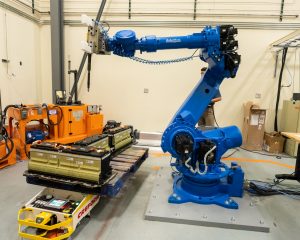By Allison Proffitt
August 23, 2021 | Researchers at the Department of Energy’s Oak Ridge National Laboratory have developed a robotic disassembly system for spent electric vehicle battery packs to safely and efficiently recycle and reuse critical materials while reducing toxic waste.
With the anticipated growth in EVs over the next two decades comes the issue of how to recycle the large lithium-ion battery packs that power them. The need is expected to be significant.
“All one must do is turn on the news each evening to hear stories about the global supply of rare earth minerals becoming more complex and monopolized,” ORNL’s Tim McIntyre, staff scientist and principal investigator in the Energy Science and Technology Directorate, told Battery Power. “Access to critical materials has become a national security issue for the United States. Greater awareness of challenged supply chains is as critical as the materials themselves.”
Only a small percentage of lithium-ion vehicle batteries are recycled today, and the majority of the processes used to do so are not automated. To make recycling more economically feasible, it must be done at high throughput and be flexible enough to process multiple consumer products in a single facility.
To address that, engineers at ORNL’s Grid Research Integration and Deployment Center have been working to show that robots can accelerate disassembly and make the process safer for workers while greatly increasing throughput.

Whether a recycler simply wants to get through the outer housing to access batteries and replace worn components, or completely recycle battery stacks for recovery of cobalt, lithium, metal foils and other materials, the first step is battery diagnostics for safe and efficient handling and disassembly.
“With our system, when the robot picks up the battery pack and puts it on the production line, it marks the last time a human will touch it until it’s in pieces and parts,” McIntyre said.
Limiting human interaction is important for both safety and efficiency. The robots swiftly remove bolts and other housing regardless of any remaining charge, whereas human operators must undertake an exacting, lengthy process to discharge used batteries before breaking them down manually. Automated disassembly reduces human exposure to toxic chemicals found inside the batteries and high power levels that are approaching the 900-volt level in some newer vehicles.
The automated system has been in development since July 2019 with several demonstrations and was developed as part of DOE’s Critical Materials Institute. Thus far, the robotic disassembly process has disassembled a few dozen batteries, McIntyre said, concentrating instead on handling a variety of pack configurations.
“The process has been designed with flexibility in mind. Detailed disassembly maps are created by a metrology system. If a stack is recognized by our vision system, the disassembly maps are uploaded to guide the disassembly process. If a stack is not recognized, it is diverted to the metrology station for fastener mapping. Our market analysis suggests many battery stacks will be duplicates. With the ability to map and store until significant duplicates are aggregated, the disassembly process can be optimized by AI tools. In cases where (one-of a-kind) tooling is needed, rapid prototyping with additive manufacturing can be employed to design and build those tools.”
The work builds on expertise developed in previous ORNL projects for the CMI that focused on robotic disassembly of hard drives for recovery of rare-earth magnets. Engineers also proved that those magnets can be directly reused in electric motors.
“Automatic disassembly of components containing critical materials not only eliminates labor-intensive manual disassembly but provides for an efficient process to separate the components into higher value streams where the critical materials are concentrated into individual feedstocks for recycle processing,” said CMI Director Tom Lograsso in a press release about the work. “This added value is an important part of establishing an economically viable process.”
The next step is to build the process up to commercial scale and develop a supply chain for spent batteries. “A consistent supply chain for Li-ion batteries must be established. With many EV/HEV battery stacks reaching their end-of-first-life, battery stack supplies will develop,” McIntyre believes. “ORNL has been in discussion with companies capable of providing these aggregation services,” he added.
The team also see opportunities to apply the same kind of disassembly system to electric vehicle drive trains for recovery of materials such as rare earth magnets, copper, steel and intact power electronics.







